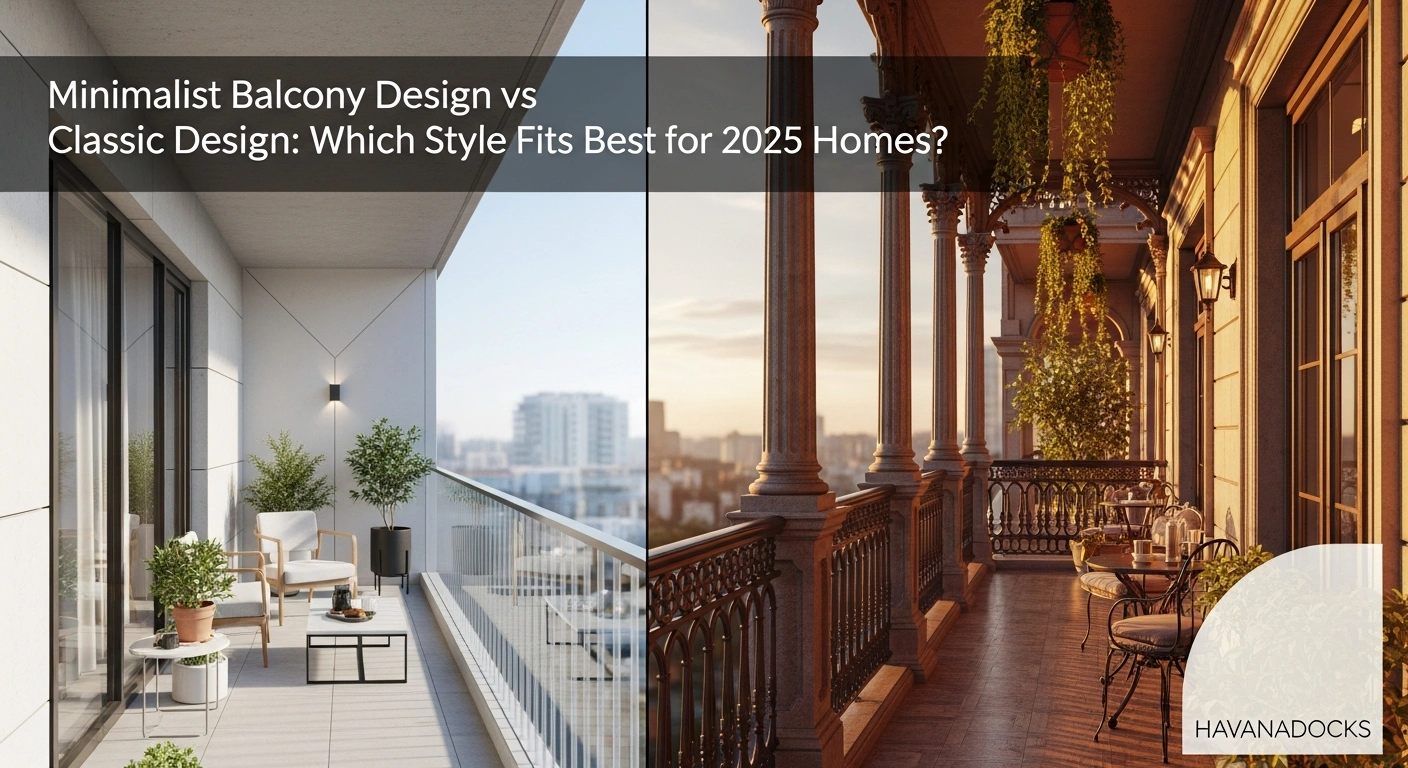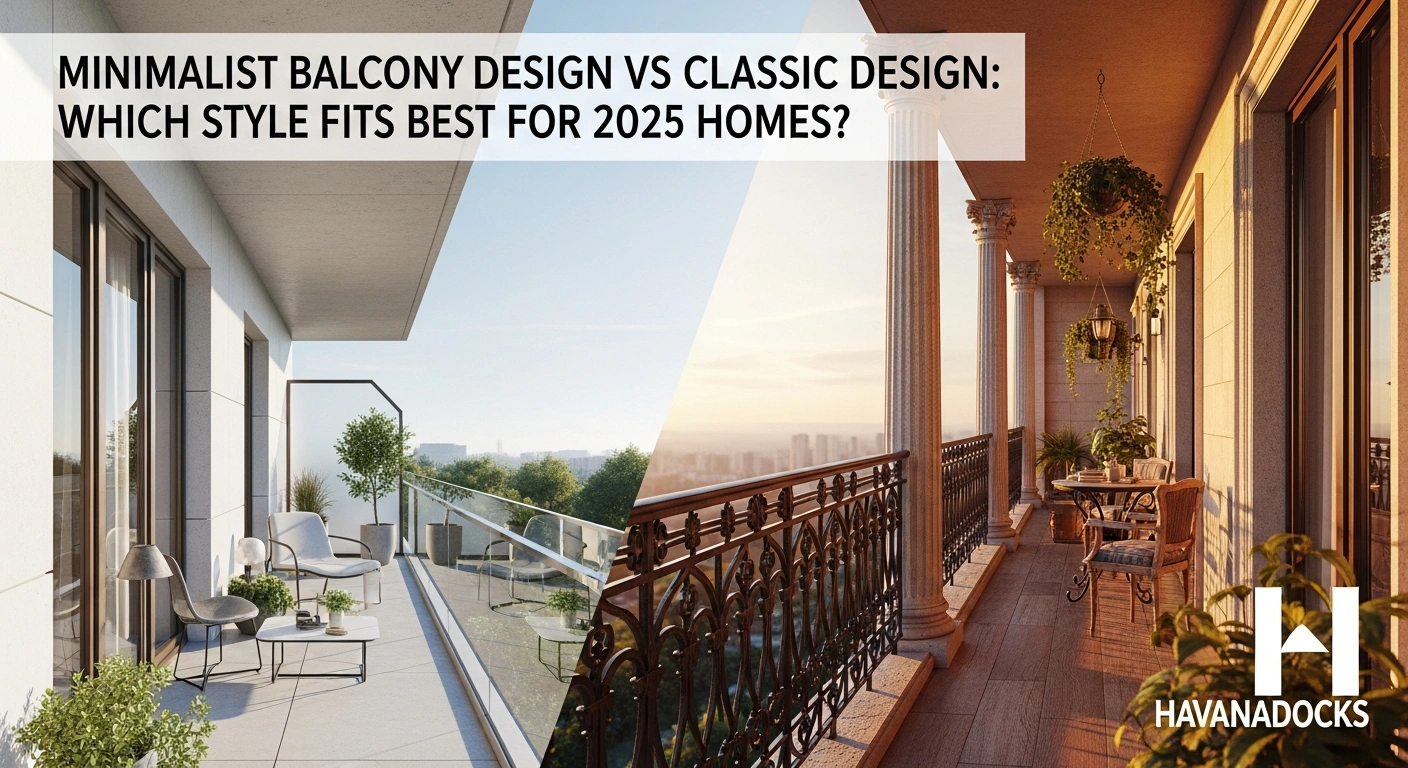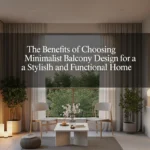Minimalist Balcony Design vs Classic Design: Which Style Fits Best for 2025 Homes?
Minimalist Balcony Design vs Classic Design: Which Style Fits Best for 2025 Homes? – The role of the balcony in modern homes has evolved far beyond a simple outdoor ledge. It has become an essential extension of our living space, a private sanctuary for relaxation, and a canvas for personal expression. As we look towards 2025, homeowners are increasingly deliberate about how they style these precious square feet, turning them into functional and beautiful retreats.
This deliberation often leads to a fundamental design crossroad, a choice between two powerful but opposing aesthetics. The decision of Minimalist Balcony Design vs Classic Home Design is more than just picking furniture; it’s about defining the purpose and atmosphere of your outdoor space. This article will provide an in-depth exploration of both styles, helping you determine which is the perfect fit for your lifestyle and the home of the future.

Understanding the Core Philosophies: Minimalism and Classicism
To make an informed choice, one must first grasp the foundational principles that guide each design style. Minimalism is a philosophy rooted in the concept of “less is more.” It champions simplicity, functionality, and the intentional use of space.
Classic design, in contrast, draws inspiration from Greco-Roman antiquity and subsequent historical periods like the Renaissance and Neoclassicism. It values order, symmetry, and a sense of timeless elegance. This style is about creating a feeling of grandeur and tradition, often through ornate details and luxurious materials.
A Head-to-Head Comparison: Aesthetics, Functionality, and Feel
The fundamental differences between these two styles become most apparent when examining their core components. From the visual language to the choice of materials, each philosophy creates a distinctly different user experience. The ongoing discourse on Minimalist Balcony Design vs Classic Home Design revolves around these tangible contrasts.
The Visual Language: Simplicity vs. Ornamentation
The aesthetic of a minimalist balcony is defined by its clean lines, uncluttered surfaces, and a deliberate lack of ornamentation. The color palette is typically neutral, focusing on shades of white, grey, beige, and black. This creates a serene and calming environment where the focus is on the space itself and the view beyond.
Classic balcony design embraces ornamentation and detail. You will find elements like decorative balustrades, intricate patterns on tiles, and shapely, elegant furniture. The color palette is often richer, incorporating deep woods, jewel tones, and metallic accents like gold or bronze to evoke a sense of opulence.
The visual impact is a primary factor in the Minimalist Balcony Design vs Classic Home Design decision. A minimalist approach offers visual restfulness, ideal for a de-cluttered modern life. A classic approach provides visual richness and a connection to historical elegance.
Space and Purpose: Maximizing Utility vs. Creating Ambiance
Functionality is a major differentiator in the Minimalist Balcony Design vs Classic Home Design comparison. Minimalism prioritizes multi-functional pieces and the efficient use of every inch. A simple bench may double as a storage box, or a sleek table might fold away to create an open area for yoga.
Classic design focuses more on creating a specific ambiance, often one of leisure and sophisticated comfort. Furniture is chosen for its comfort and aesthetic contribution rather than its multi-functionality. The purpose is to create a dedicated space for specific activities like enjoying a morning coffee or an evening cocktail in a luxurious setting.
Therefore, the choice depends heavily on your lifestyle. If you need your balcony to serve multiple purposes, the minimalist approach is likely more suitable. If you envision it as a dedicated, elegant escape, the classic style will better serve that goal.
Material Palette: Natural & Sleek vs. Rich & Timeless
The materials used are central to each design’s identity. Minimalist balconies often feature materials like polished concrete, light-toned woods such as bamboo or birch, and metals like stainless steel or powder-coated aluminum. Glass is frequently used for railings to enhance the sense of openness and light.
In the classic corner of the Minimalist Balcony Design vs Classic Home Design debate, materials are chosen for their richness and historical resonance. Wrought iron is a staple for railings and furniture, often featuring intricate scrollwork. Natural stones like marble or travertine, along with traditional terracotta tiles, are common for flooring, while dark, polished woods like mahogany create a sense of enduring quality.
The textural experience of each style is profoundly different. Minimalism feels sleek, clean, and often cool to the touch. Classic design feels substantial, textured, and connected to natural, time-honored craftsmanship.

Aligning Your Balcony with 2025 Home Trends and Lifestyles
As we move towards 2025, several overarching trends in housing and lifestyle are shaping design choices. These include the rise of urban living in compact spaces, a growing emphasis on sustainability, and the seamless integration of technology. The suitability of Minimalist Balcony Design vs Classic Home Design can be evaluated against these modern priorities.
The Rise of Urban Living and Compact Spaces
Urbanization continues to be a dominant global trend, leading to an increase in apartment and condominium living. Balconies in these settings are often small, making efficient space planning a necessity. This is where minimalist design truly shines.
The minimalist ethos of “less is more” directly addresses the challenge of limited square footage. By using a restrained color palette, simple forms, and multi-functional furniture, a small balcony can be made to feel larger and more open. This approach avoids the visual clutter that can make a compact space feel cramped and overwhelming.
While a classic design can be adapted for a smaller balcony, it can be more challenging. The inherent preference for larger, more ornate furniture can quickly consume the available space. A successful classic small balcony requires careful curation, perhaps focusing on a single, elegant bistro set and a few carefully chosen planters rather than attempting to replicate a grand terrace. This particular context often tips the scales in the Minimalist Balcony Design vs Classic Home Design consideration.
In 2025, as urban density increases, the functionality and space-enhancing qualities of minimalism will likely appeal to a wider audience. It provides a practical and aesthetically pleasing solution for the modern city dweller. The debate of Minimalist Balcony Design vs Classic Home Design is often settled by the sheer reality of available space.
Sustainability and Technology Integration
In 2025, the modern homeowner’s priorities have evolved far beyond aesthetics. Environmental responsibility and technological innovation now sit at the core of design decisions. As we reimagine the home for the future, sustainability and smart living are no longer optional luxuries — they are essential benchmarks of thoughtful design. This dual focus has become a defining element in the ongoing dialogue between Minimalist Balcony Design vs Classic Home Design.
The Sustainable Ethos of Minimalism
Minimalist design, by its very nature, aligns harmoniously with the principles of sustainability. Its philosophy of “less but better” discourages excess consumption and promotes longevity. On the balcony, this manifests through the use of eco-friendly materials like recycled aluminum railings, sustainably sourced hardwood decking, or composite alternatives made from reclaimed plastics and wood fibers.
Energy-efficient lighting, such as low-voltage LEDs powered by solar panels, subtly blends function with environmental mindfulness. Planters made from biodegradable or recycled materials further enhance the green ethos, allowing even small spaces to contribute positively to the ecosystem. The minimalist balcony often doubles as a micro-garden or green retreat, where vertical planting systems and native species reduce heat absorption and encourage biodiversity.
Moreover, minimalist design celebrates energy efficiency and natural balance. Clean lines and uncluttered layouts allow for better air circulation and optimal sunlight exposure, reducing the reliance on artificial climate control. The result is a space that feels open, airy, and effortlessly sustainable — a visual and ethical reflection of modern living values.
The Classic Approach to Sustainability
Classic home design, in contrast, takes a more heritage-based approach to sustainability. Its emphasis on enduring craftsmanship and natural materials naturally supports longevity. Stone, iron, and hardwood are often locally sourced and built to last for generations — a sustainable practice rooted in the principle of permanence rather than disposability.
While a classic balcony might not overtly showcase sustainability through sleek solar panels or minimalist materials, its longevity is its eco-friendly statement. The careful preservation and restoration of existing architectural elements, rather than replacement, contribute to a lower carbon footprint over time. The timeless design also resists the fast-changing tides of trends, reducing the need for frequent renovations — an often-overlooked yet powerful form of environmental responsibility.
Eco-Conscious Choices in Balcony Design
Sustainability in design focuses on using renewable materials, reducing waste, and choosing items with a long lifespan. Minimalism aligns naturally with many of these principles. Materials like bamboo (a fast-growing grass), recycled composite decking, and furniture made from reclaimed wood fit perfectly within the minimalist aesthetic.
The classic approach to sustainability focuses more on longevity and natural materials. Using high-quality, durable materials like stone and wrought iron means they will not need to be replaced for decades, reducing long-term waste. The emphasis is on timeless quality and craftsmanship that endures, which is in itself a form of sustainability. When considering longevity in the Minimalist Balcony Design vs Classic Home Design framework, classic materials often have an edge.
Smart Balconies: The Role of Technology
Technology integration is another key trend for 2025 homes. This can include automated irrigation systems for plants, smart ambient lighting controlled by an app, or integrated outdoor speakers. In this area, the Minimalist Balcony Design vs Classic Home Design question is about how technology is expressed.
In a minimalist design, technology is typically integrated seamlessly and hidden from view. LED light strips might be concealed beneath a railing, and speakers may be disguised as rocks or integrated into the ceiling. The goal is for the technology to provide function without disrupting the clean visual lines.
In a classic design, technology can be either discreetly hidden or presented as a feature of modern luxury. A sleek, wall-mounted weather station could complement the wrought iron, or elegant, traditionally styled lantern fixtures could house smart bulbs. The integration is about blending modern convenience with timeless style.

Making the Decision: Practical Factors to Consider
Choosing between these two compelling styles ultimately comes down to a combination of personal preference, your home’s existing architecture, and practical considerations like budget and maintenance. The final verdict in your personal Minimalist Balcony Design vs Classic Home Design journey requires careful thought. This is about creating a space that you will love and use for years to come.
Your home’s overall architectural style is a significant factor. A modern, angular building with large glass windows is a natural canvas for a minimalist balcony. Conversely, a home with traditional architectural features, such as a Victorian or Colonial-style house, will likely be more harmonious with a classic balcony design. For many, the choice of Minimalist Balcony Design vs Classic Home Design is heavily influenced by the building’s exterior.
Your lifestyle and how you intend to use the balcony are paramount. If you envision a flexible space for exercise, entertaining, and quiet contemplation, minimalism’s adaptability is a strong asset. If you dream of a romantic, dedicated space for tranquil evenings and intimate conversations, the ambiance of a classic design may be unbeatable. The essence of the Minimalist Balcony Design vs Classic Home Design question is “how will I live in this space?”
Maintenance is another practical consideration. The clean surfaces and simple forms of a minimalist balcony are generally easier and quicker to clean. Classic designs, with their ornate details in wrought iron and porous materials like terracotta, can require more time and effort to maintain their pristine appearance. This practical aspect is a crucial point in the Minimalist Balcony Design vs Classic Home Design deliberation for busy homeowners.
Finally, consider your budget. While both styles can be achieved at various price points, the material choices can have a significant impact. High-end minimalist design featuring custom metalwork can be expensive, but the style also lends itself well to budget-friendly DIY solutions. Classic design, with its reliance on materials like solid stone, high-quality dark woods, and artisan metalwork, can often carry a higher initial cost.
The complexity of choosing between Minimalist Balcony Design vs Classic Home Design is clear. It requires a holistic view of your home, your life, and your priorities. There is no single right answer, only the answer that is right for you. Each homeowner must weigh these factors in their own Minimalist Balcony Design vs Classic Home Design comparison.
The market for 2025 responds to both aesthetics, offering a vast array of furniture, materials, and accessories. This availability ensures that no matter which path you choose in the Minimalist Balcony Design vs Classic Home Design spectrum, you can find the resources to bring your vision to life. The beauty of modern design is this very flexibility.
As home design becomes increasingly personalized, the trend is moving away from rigid adherence to a single style. Many homeowners find satisfaction in blending elements from both philosophies. A predominantly minimalist balcony might be softened with a single, ornate classical planter, creating an interesting focal point that adds personality and depth.
Ultimately, the great debate of Minimalist Balcony Design vs Classic Home Design serves as a guide, not a set of rigid rules. It encourages you to think critically about what you value in a living space: the calm of simplicity or the richness of history. The best design for your 2025 home is one that feels like a true extension of yourself. For many, the answer to the Minimalist Balcony Design vs Classic Home Design challenge is a personalized hybrid.
The importance of the balcony as a functional living area will only grow. It is a space for connecting with nature, finding peace in a busy world, and expressing personal style. The Minimalist Balcony Design vs Classic Home Design framework helps us to be intentional about creating these vital personal sanctuaries. This thoughtful approach is what defines contemporary home design.
Understanding the deep-seated principles of each style empowers you to make a choice that goes beyond fleeting trends. The core of the Minimalist Balcony design vs Classic Home Design choice is about creating timeless appeal. Whether you opt for the serene emptiness of minimalism or the decorative fullness of classicism, your decision will shape your daily moments of outdoor reprieve. The continuing relevance of the Minimalist Balcony Design vs Classic Home Design discussion shows its importance.
The discussion around Minimalist Balcony Design vs Classic Home Design will undoubtedly continue as home trends evolve. However, the foundational principles of functionality, aesthetics, and personal comfort will remain constant. By understanding these pillars, you are well-equipped to design a balcony that is not only stylish for 2025 but also a perfect fit for you. The journey of exploring the Minimalist Balcony Design vs Classic Home Design topic is an investment in your home’s future.
Many design experts see the future not as a victory for one style over the other, but as a fusion. The Minimalist Balcony Design vs Classic Home Design dichotomy may soften into a spectrum. We may see more “warm minimalism” that incorporates classic textures or “modern classicism” that simplifies traditional forms. Every homeowner’s home will be a unique answer to the Minimalist Balcony Design vs Classic Home Design question.
This evolution reflects a broader cultural shift towards personalization and authenticity. The best homes of 2025 will be those that tell a story about their inhabitants. And the balcony, your personal threshold between the indoors and outdoors, is a perfect chapter in that story. The Minimalist Balcony Design vs Classic Home Design debate provides the essential vocabulary for writing it.
Conclusion: Crafting Your Personal Sanctuary for 2025
The choice between Minimalist Balcony Design vs Classic Home Design is a deeply personal one with no single correct answer for every 2025 home. Minimalism offers a serene, functional, and space-enhancing solution perfectly suited to the demands of modern urban living. Its focus on simplicity and utility provides a calming antidote to a cluttered world.
In contrast, Classic design offers a connection to history, a sense of timeless elegance, and an atmosphere of luxurious comfort. It transforms a balcony into a romantic and sophisticated retreat, prioritizing ambiance and rich detail. The long-running debate of Minimalist Balcony Design vs Classic Home Design highlights two valid, powerful paths to creating a beautiful outdoor space.
Ultimately, the best style for your balcony is the one that aligns with your home’s architecture, supports your lifestyle, and brings you joy. Whether you choose the clean-lined tranquility of minimalism, the ornate charm of classicism, or a thoughtful blend of both, the goal is to create a personal sanctuary. By carefully considering the points raised in the Minimalist Balcony Design vs Classic Home Design analysis, you can craft an outdoor space that will enrich your life for years to come.






